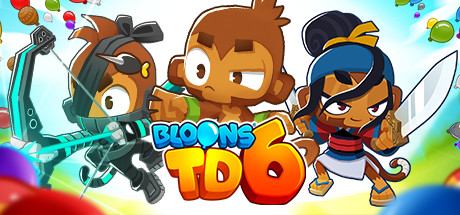Are you looking for some help with tower placement in Bloons TD 6? This guide is perfect for you! Here you will find all the information you need to start placing towers correctly and never make placement mistakes again. This guide will explore the considerations and subtleties that you should think about when placing towers, and will provide you with some useful tools and rules. So if you’re ready, let’s get started!
1. Distance and Angle of Attack
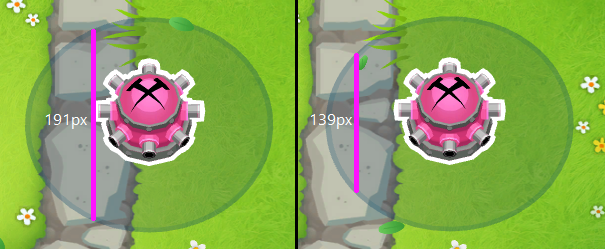 Figure 1
Figure 1
In figure 2, an exception arises. The tack shooter that is closer to the track has less track coverage than his contemporary.
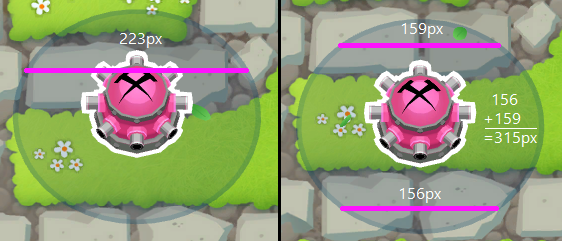 Figure 2
Figure 2
In this situation, then, is placing the tower centered between strips of track better, as seen in the second example? As always, it depends. Towers that fire projectiles with a greater than 0 travel time, cannot seek out bloons, and don’t apply a DOT (damage over time) effect, such as tack shooters, almost always benefit from being closer to the track, even at the cost of less track coverage. That may sound like a lot of qualifiers, but the majority of towers fall into this group. When a projectile-tower is closer, the angle that their projectile travels is steeper in relation to the track, potentially allowing more of the projectile’s pierce to be utilized. In figure 3, we can see that the dart monkey closer to the track has a steeper firing angle for the higher track. Having placed it adjacent to the higher track as opposed to placing it 1 dart monkey’s diameter away, we see that the closer placement has a 133% steeper firing angle, potentially allowing for 133% more pierce to be utilized.
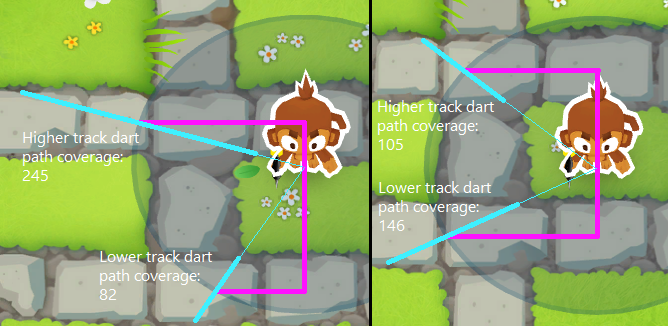 Figure 3
Figure 3
The lower placed dart monkey does have a better firing angle on the lower track, but as we can see if we add the 2 path coverage scores together, (245+82=327, 105+146=251) the closer dart monkey is still getting 30% more coverage with the path’s of his darts. The difference between these scores can be made less drastic by increasing the tower’s range. Many players already know this in one way or another. An easily recognizable example is the 3-x-x dart monkey spike-o-pult, which is often set to last targeting. When targeting the last bloon, the spike-o-pult is firing at the edge of its range; its steepest firing angle; allowing more of its massive reserve of pierce to be used.
There is a problem, however. Can you see how the dart monkey’s placement could be more optimal without changing its horizontal coordinate? Assuming you can, you realized that placing the dart monkey adjacent to the lower track is superior to placing it adjacent to the higher track. The firing angle scores are the same, as are the track coverage scores, but there are more factors to consider. When the dart monkey is set to first targeting, the most common targeting, the dart monkey will be throwing with a poor firing angle at bloons on the lower track. As bloons exit the dart monkey’s range, he will retarget the next first bloon. This bloon, however, will likely be on the lower track, meaning that as a constant stream of bloons trek along the path, the dart monkey will be firing at the lower track much more often. This is why many players set their spike-o-pults to last targeting. It allows them to have an optimal firing angle more often while placing the dart monkey farther ahead on the track, speeding up the time each round takes. In a test of two engineer monkeys versus round 15, one placed adjacent to the higher track and one placed adjacent to the lower track, the higher engineer monkey got 107 pops while the lower monkey got 110 pops. That is not very significant, but compounding optimizations can make significant differences. Because Monkey Meadow has more track than is shown, placing the tower in the higher position can yield better results, as projectiles fly off into other parts of the track damaging more bloons.
On the topic of dart monkeys and engineer monkeys, the origin of their projectile is not centered on the tower. The projectile leaves the tower slightly to the right of its center. While not particularly significant, it can affect the tower’s angle of attack. In the previous example, the dart monkey placed lower has a better firing angle when targeting the lower track as the dart originates from the right side, spawning it slightly closer to the track. Tack shooters have a similar quirk; the origin of their radial attack is not centered on the tower’s base, and is in fact slightly higher. Because of this, it’s especially important to place tack shooters beneath the track instead of above it.
2. Opportunities of Attack
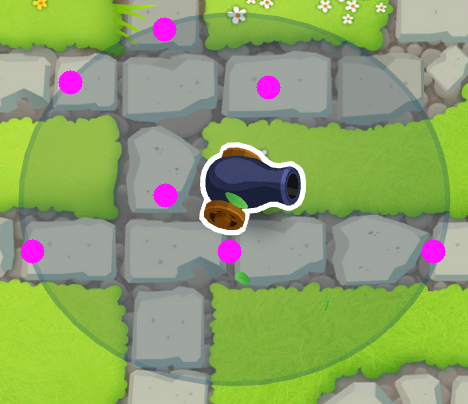 Figure 4
Figure 4
You may still be unsure what an OOA is. An OOA is simply every moment a bloon enters a tower’s range. In figure 5, the total track coverage has been tallied for both placements, and the points where the wizard attacked are marked.
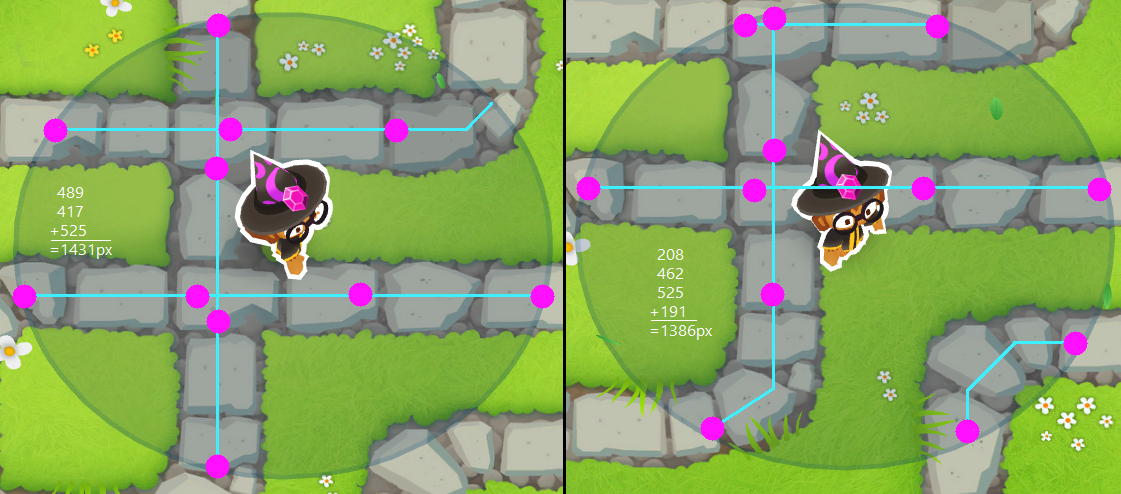 Figure 5
Figure 5
The wizard on the left has 1431 total track coverage, but only attacked 11 times, whereas the right wizard only has 1386 coverage, but attacked 12 times. What is the difference here? The left wizard has 3 OOAs and the right wizard has 4. It’s also important to consider that the right wizard attacked as the bloon left his range on all 4 OOAs. The wizard attacks rather slowly. If we conduct the same test with a super monkey, a tower that attacks very fast, we see that in the OOA position he gets 234 pops, and in the coverage position he gets 238 pops, only 1.5% off what would be assumed based on the track coverage (likely meaning I mismeasured slightly).
It’s important to consider that, because the initial attack takes no time at all, even the slimmest portion of track is equally as valuable as a much longer stretch that still only allows one attack to be made. In figure 6, I’ve placed two sniper monkeys on Cornfield. Snipers have neither velocity nor range, and they generally attack very slowly. In the case of Elite Sniper, his projectiles also ricochet, which makes OOAs even more important. If you are saving money by not removing corn, which placement might you pick?
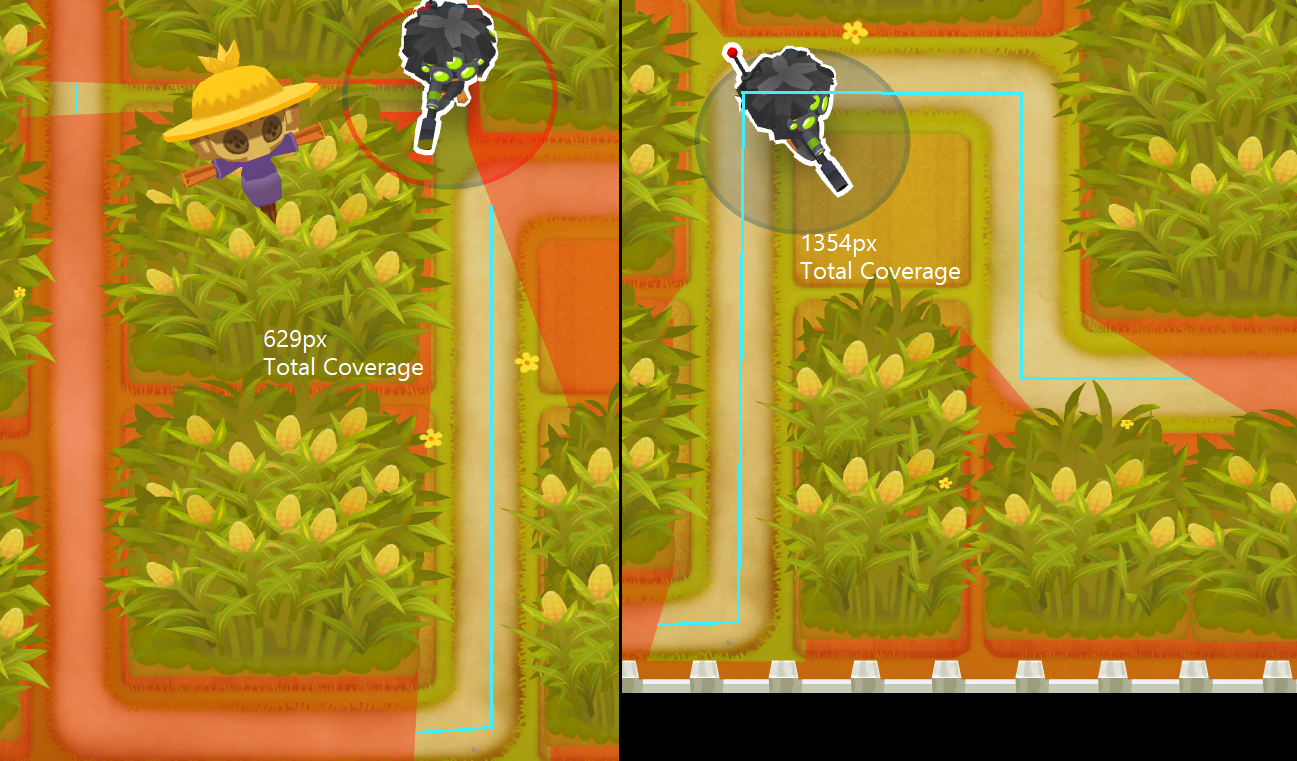 Figure 6
Figure 6
In the left position, the sniper got 3982 pops on round 63 set to elite targeting. The right sniper got 4334 pops. Clearly, the right position is better, right? Consider that the left position has less than half the coverage. The left position gets 97% more pops per pixel covered, and allows shorter range towers to use the valuable center positions all because of 1 additional OOA. This is, of course, a give-and-take. The right position is superior if you have no other towers to be placed in that spot, but the left position does more with less and allows another tower to be placed in the middle. When placing multiple towers its critical that all future tower positions are considered. If, available, are two tower placements that are 100% and 80% optimal, but to another tower would be 100% and 50% optimal, It may be wise to use the 80% position and allow the other tower to fill the most optimal spot.
3. Interference and MOAB class bloons.
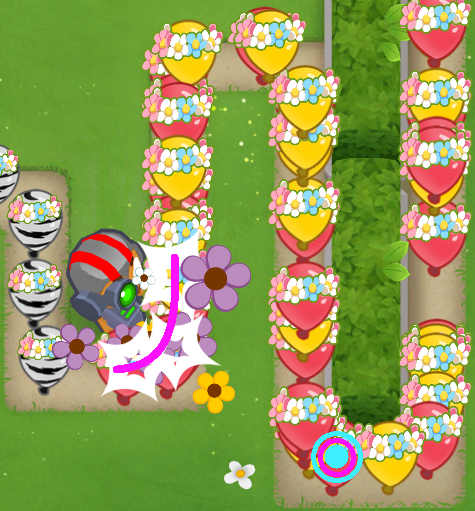 Figure 7
Figure 7
Below is figure 8, it is similar to figure 5 but the wizard towers have larger ranges, such that the left example can target the portion of track in the bottom right. If bloons were traveling along the second to last section, the final section of track would be obscured, possibly allowing bloons to leak. In figure 8, we can see exactly how much of the track is visible assuming a constant stream of bloons. Cyan lines mark visible track and magenta marks obscured track.
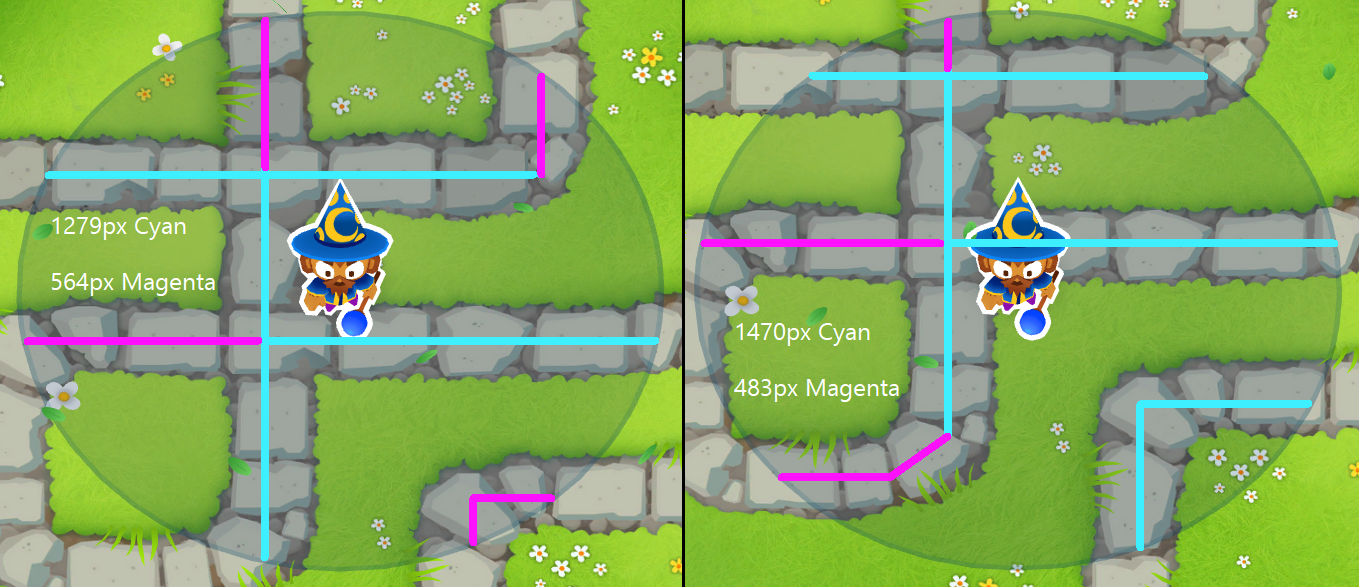 Figure 8
Figure 8
With 1279/564 and 1470/483 respectively, the left wizard has 31% of the track obscured while the right has only 25%. In a test between two 0-0-5 ice monkeys placed in the positions shown in figure 8 versus round 98, a round requiring an abundance of pierce, the lower ice got ~217k pops and the higher got ~195k. The lower ice monkey has 6% more track coverage, but got 11% more pops.
Excluding interference, the analysis so far has assumed that the projectiles and targets are not significantly different from points; something that has yet to be touched on are hitboxes. Projectile hitboxes won’t be mentioned, but bloon hitboxes will as they can be quite important, especially MOAB class bloons. Because MCBs’ (MOAB class bloon’s) hitboxes extend beyond the width of the track, they can be targeted before their center-most-point is in range of the tower. This is also true for regular bloons, but to a much less significant degree. Some towers need only target MCBs, making the accidental striking of regular bloons a waste. In figure 9, there are 3 examples, each one showing a case where the large hitboxes of MCBs are considered or taken advantage of.
 Figure 9
Figure 9
In the first example, the 0-3-2 spike factory is targeting smart, which places spikes at the point on the track closest to the exit. In this spot, spikes will collide with the large MOAB class bloons, but regular bloons will float past, right into the 4-2-0 Spiked Mines, who excels at popping regular bloons. In the second example, the 0-0-3 glue gunner is placed a small distance from the track, ensuring that he can target the first MCB along the track without his projectile getting caught on farther back MCBs. Because he has either no or little piece, the firing angle is largely irrelevant. Finally, the third example shows a 5-0-0 ice monkey placed in such a way that he can strike MCBs in 3 directions, but cannot strike regular bloons. This is good, as placing farther in any direction would lower the total MCB coverage. Not being able to strike regular bloons is not a detriment to Super Brittle as its pierce is better spent on MCBs.
And that wraps up our share on Tower Placement Optimization, or How to Place Towers in BTD6. If you have any additional insights or tips to contribute, don’t hesitate to drop a comment below. For a more in-depth read, you can refer to the original article here by Lego Enthusiast, who deserves all the credit. Happy gaming!
